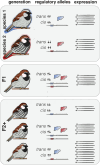Hybridization and gene expression: Beyond differentially expressed genes
- PMID: 38411307
- PMCID: PMC12288826
- DOI: 10.1111/mec.17303
Hybridization and gene expression: Beyond differentially expressed genes
Abstract
Gene expression has a key role in reproductive isolation, and studies of hybrid gene expression have identified mechanisms causing hybrid sterility. Here, we review the evidence for altered gene expression following hybridization and outline the mechanisms shown to contribute to altered gene expression in hybrids. Transgressive gene expression, transcending that of both parental species, is pervasive in early generation sterile hybrids, but also frequently observed in viable, fertile hybrids. We highlight studies showing that hybridization can result in transgressive gene expression, also in established hybrid lineages or species. Such extreme patterns of gene expression in stabilized hybrid taxa suggest that altered hybrid gene expression may result in hybridization-derived evolutionary novelty. We also conclude that while patterns of misexpression in hybrids are well documented, the understanding of the mechanisms causing misexpression is lagging. We argue that jointly assessing differences in cell composition and cell-specific changes in gene expression in hybrids, in addition to assessing changes in chromatin and methylation, will significantly advance our understanding of the basis of altered gene expression. Moreover, uncovering to what extent evolution of gene expression results in altered expression for individual genes, or entire networks of genes, will advance our understanding of how selection moulds gene expression. Finally, we argue that jointly studying the dual roles of altered hybrid gene expression, serving both as a mechanism for reproductive isolation and as a substrate for hybrid ecological adaptation, will lead to significant advances in our understanding of the evolution of gene expression.
Keywords: RNAseq; evolutionary novelty; gene networks; speciation; transcriptomics.
© 2024 The Authors. Molecular Ecology published by John Wiley & Sons Ltd.
Conflict of interest statement
The authors declare no conflicts of interest.
Figures



References
-
- Alger, E. I. , & Edger, P. P. (2020). One subgenome to rule them all: Underlying mechanisms of subgenome dominance. Current Opinion in Plant Biology, 54, 108–113. - PubMed
-
- Arévalo, L. , Gardner, S. , & Campbell, P. (2021). Haldane's rule in the placenta: Sex‐biased misregulation of the Kcnq1 imprinting cluster in hybrid mice. Evolution, 75, 86–100. - PubMed
Publication types
MeSH terms
Grants and funding
LinkOut - more resources
Full Text Sources

